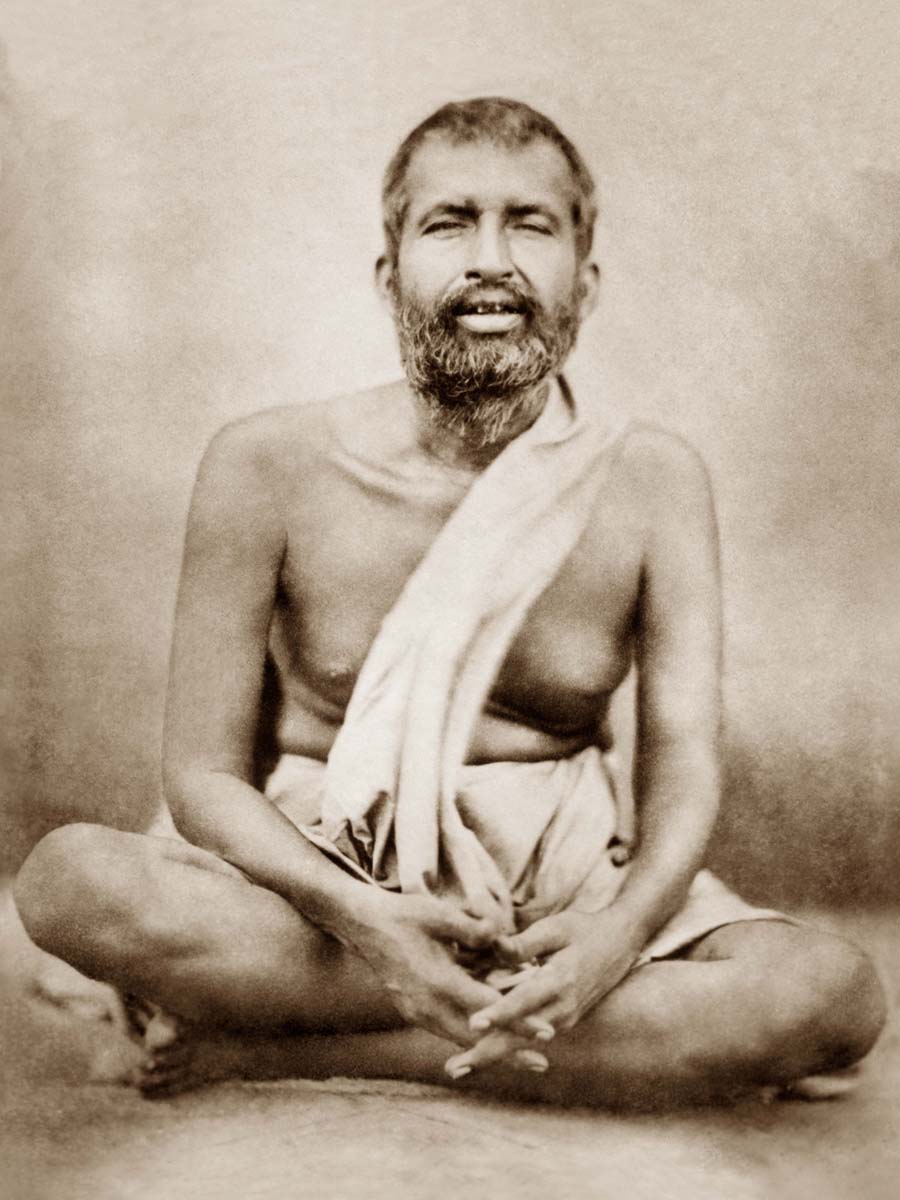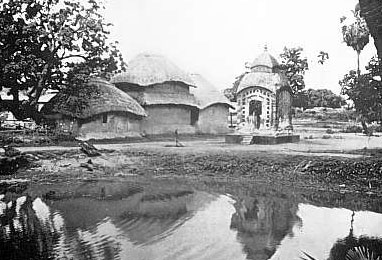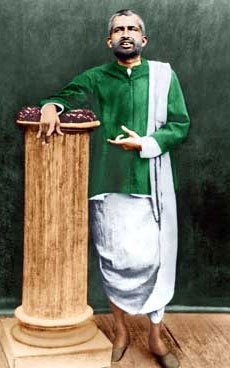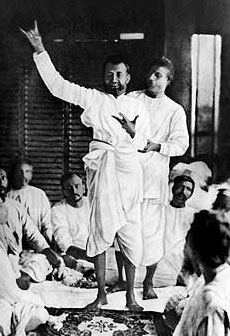Sri Ramakrishna - A Biography
 Sri Ramakrishna was born in a village called Kamarpukur in the district of Hugli (Bengal) on Wednesday, the 18th of February 1836. He came of a highly respected, though poor, Brahmin family.
Sri Ramakrishna was born in a village called Kamarpukur in the district of Hugli (Bengal) on Wednesday, the 18th of February 1836. He came of a highly respected, though poor, Brahmin family.
Sri Ramakrishna's father, Khudiram Chatterjee, was a great devotee. His mother Chandramani Devi was the personification of kindness. In her there was no guile.
Sri Ramakrishna was called Gadadhar in his childhood. He received some lessons in reading, writing and arithmetic at the village primary school.
After leaving the village school, the boy was not allowed to sit idle at home. His next duty was to attend to the daily worship of his household God Raghuvir. Every morning he chanted the name of the Lord, put on a holy garment, and gathered flowers. After ablutions, prayers and meditation on the Supreme Being, the One and Indivisible God, he worshipped Raghuvir, also called Rama, one of the Incarnations of the Supreme Being, and the Hero of the well-known epic, the Ramayana. He could sing divinely. The songs that he heard during theatrical performances, he could recite from beginning to end. From a boy, he was always happy. Men, women and children - everybody loved him.
Brahmin scholars were often, as is the practice amongst the Hindus, engaged to read from the Sacred Books about the Life and Teachings of the various Incarnations of God, and sing and narrate the incidents in the vernacular. Sri Ramakrishna would listen to these men with rapt attention. In this way he mastered the Ramayana, the Mahabharata and the Bhagavata - all religious epics relating to Rama and Krishna who are both regarded by the Hindus as Incarnations of God.
When eleven years old, Sri Ramakrishna was one da y going through the corn-fields to Anur, a village near Kamarpukur. As he told his disciples afterwards, he suddenly saw a Vision of Glory and lost all sense-consciousness. People said, it was a fainting fit; but it was really that calm and serene mood, that superconscious state, called Samadhi, brought on by God-vision.
y going through the corn-fields to Anur, a village near Kamarpukur. As he told his disciples afterwards, he suddenly saw a Vision of Glory and lost all sense-consciousness. People said, it was a fainting fit; but it was really that calm and serene mood, that superconscious state, called Samadhi, brought on by God-vision.
After the death of his father, Sri Ramakrishna, then seventeen or eighteen years old, went with his elder brother to Calcutta. The brothers came down to Calcutta with an intention of seeking their fortune.
Rani Rashmani, a rich and pious Bengali lady, built the well-known temple at Dakshineswar, a village about four miles from Calcutta, in 1855 A.D. The eldest brother of Sri Ramakrishna Pandit Ram Kumar, was appointed the chief priest of the temple of Mother Kali, the Goddess.
Sri Ramakrishna used often to come to the temple to see his brother. Within a few days he was himself employed as an assistant priest.
In the course of a few days a change came over Sri Ramakrishna. He was found sitting alone for long hours before the Image of the Mother. Evidently his mind was drawn away from things of this world. It was in quest of some Object not sought by men of the world.
 His people shortly arranged his marriage. They hoped that marriage would turn his mind away from his Ideal World. But the marriage had been only in name. His newly married bride Sri Sri Saradamani Devi was also an illumined soul of the highest order. After his marriage Sri Ramakrishna returned to the temple-garden at Dakshineswar. This was the turning point of his godly life. In a few days, while worshipping the Mother, he saw strange Visions of Divine Forms.
His people shortly arranged his marriage. They hoped that marriage would turn his mind away from his Ideal World. But the marriage had been only in name. His newly married bride Sri Sri Saradamani Devi was also an illumined soul of the highest order. After his marriage Sri Ramakrishna returned to the temple-garden at Dakshineswar. This was the turning point of his godly life. In a few days, while worshipping the Mother, he saw strange Visions of Divine Forms.
It was soon found by the temple authorities that Sri Ramakrishna was, in the present state of his religious feelings, incapable of doing the duty of a priest any longer. Nor could he go on doing his duties as a householder. He said 'Mother, O ! Mother !' night and day.
There was a guest-house in the Temple-garden. Holy men who had given up the world used to come there as guests. Tota Puri, a holy man, stayed there as a guest for eleven months. He it was who expounded to Sri Ramakrishna, the Vedanta philosophy. During the exposition Tota observed that his disciple was no ordinary man, and that he frequently went into a state of Divine Ecstasy in which the finite ego goes out of sight and becomes one with God,' the Universal Ego!
A Brahmin lady who had also given up the world came as a guest to the Temple a little before Tota Puri. She it was who helped Sri Ramakrishna to go through the practices enjoined by the Scriptures called the Tantras.
He used to pass through three different states of religious consciousness viz., the purely Internal or Super-consciousness State, in which there can be no outward consciousness; the Half-conscious State in which outward perception is not entirely lost; and the Conscious State in which it is possible for one to chant the holy name of the Lord. With 'Mother, O! Mother!' ever on his lips, he would talk to the Divine Mother without cessation. He would ask Her to teach him. He would often say, 'O Mother, I know not the Sacred Books; nor have I anything to do with the pandits well versed in them. It is Thou alone whose words I shall hear. Teach Thou and let me learn.'
The sweet name of Mother, Sri Ramakrishna applied to the Supreme Being, God the Absolute, who transcends all thought, all time and space.
 Besides teaching the fact that God may be seen, his great object was to point out the harmony amongst all religions. He realised, on the one hand, the Ideal set up by each of the various sects of the Hindu religion, and on the other, the Ideal of Islam and that of Christianity. He recited in solitude the name of Allah and meditated upon Jesus Christ. In a vision he saw Jesus in his glory. In his chamber he made room for the pictures not only of Hindu Gods and Goddesses including Buddha, but also for that of Jesus.
Besides teaching the fact that God may be seen, his great object was to point out the harmony amongst all religions. He realised, on the one hand, the Ideal set up by each of the various sects of the Hindu religion, and on the other, the Ideal of Islam and that of Christianity. He recited in solitude the name of Allah and meditated upon Jesus Christ. In a vision he saw Jesus in his glory. In his chamber he made room for the pictures not only of Hindu Gods and Goddesses including Buddha, but also for that of Jesus.
He looked upon all women as incarnations of the Divine Mother and he worshipped them as such. Ramakrishna fell sick with cancer in the throat in 1885. He was removed to Cossipore for treatment. By now he had come to be known as a great religious teacher. Many of the Calcutta elite came under his influence, but Ramakrishna was not satisfied until he had a band of young men who were prepared to mould themselves strictly according to his instructions. Such young men came, fifteen or sixteen in number, all with a good family background, and modern education. All of them are now well-known, for their later achievements as religious teachers, most of all their leader Swami Vivekananda, who in fact influenced every aspect of Indian national life. It is this band of young men who later formed the Ramakrishna Order.
Many are those who have become and are becoming his followers to-day. The family of his disciples lies scattered to-day not only in Asia including Japan, but also in America and Europe.
Sri Ramakrishna entered into Mahasamadhi in Cossipor Gardens House near Calcutta on 16 August, 1886.

 Print Article
Print Article